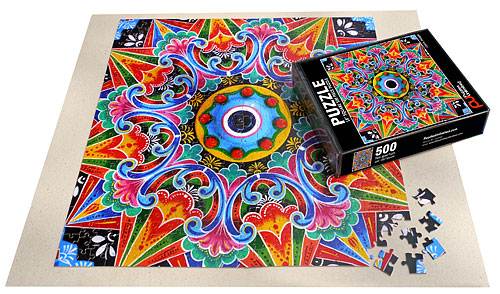4 Attributes of a Best Selling Jigsaw Puzzle

As a branded puzzle manufacturer, we understand that producing a best selling jigsaw puzzle is hard so we have put together this short guide explaining what you can do to create the perfect jigsaw puzzle and give yourself the best chance of sales success.
The biggest factor you have influence over is the selection of the artwork or images. This is a critical factor in creating a great puzzle. When choosing an image, it’s important to consider not only its resolution, color contrast, and complexity but its suitability for the puzzle size you want. The size of the puzzle will be dictated by the dimensions of the image, and selecting the right size is key to ensuring that the puzzle not only looks great but also offers an enjoyable and satisfying puzzling experience. In this article, we will provide expert guidance on selecting the perfect image and puzzle size to create the ultimate jigsaw puzzle.
Criteria for Selecting the right Image for your Best Selling Jigsaw Puzzle
1. Image Quality
The image should be high-quality, clear, and vibrant, without blurry or distorted areas. This is because the picture is the main focus of the puzzle and the main reason why people will be motivated to purchase and assemble the puzzle.
Selecting a clear and vibrant image makes the puzzle visually appealing, and more enjoyable to assemble. A blurry or distorted image will make the puzzle frustrating to put together and will ultimately lead to a negative experience for the person assembling it.
Furthermore, a high-quality image will make the puzzle more marketable and appealing to potential buyers. If the image is eye-catching and attractive, people will be more likely to purchase the puzzle as a gift or for themselves. This is especially true for puzzles that are being used for fundraising or promotional purposes, where the image can make all the difference in a campaign’s success.
2. Image Composition
Why is a well-composed image important for a puzzle? Well, when you’re putting together a puzzle, you’re essentially piecing together a work of art. And just like any other work of art, the image’s composition plays a crucial role in its overall impact and appeal. A well-composed image can make the difference between a frustrating puzzle that’s no fun to assemble, and a challenging but satisfying puzzle that’s a joy to work on.
So, what makes a good image composition for a puzzle?

There are a few key things to keep in mind. First, you want to choose an image that has a clear focal point. This could be a person, an object, or a landscape feature, but it should be something that immediately draws the eye and gives the puzzle some structure. Without a clear focal point, the puzzle can start to feel chaotic and overwhelming, which can be frustrating for the person putting it together.
Avoid selecting images or artwork that have large areas of the same color as this can become boring to solve. Some examples of images that work well for puzzles include:
Artwork: All types of artwork work well as long as it is bold and colorful with lots of detail. While there are no rules as to art style, impressionist, post-impressionist, and abstract paintings are often popular choices, as they offer a sense of complexity and intrigue that can make for an enjoyable puzzling challenge. Of course, personal preference also plays a big role in image selection, so it’s always a good idea to choose an image that speaks to you or your intended audience.
Patterns: Abstract patterns, such as mandalas or geometric designs, can also work well for puzzles. These images offer a different kind of challenge, as the assembler must focus on color and shape rather than a specific subject matter.
Landscapes: Beautiful scenic views, such as mountains, beaches, and forests, make great puzzle images. They offer a sense of peacefulness and tranquility, and the variety of colors and textures in the image can make for an interesting puzzle challenge.
Animals: Images of animals, both domestic and wild, are popular choices for puzzles. The subject matter offers a wide range of colors and textures and can appeal to both children and adults.
3. Colors
Ah, colors! They play a crucial role in the world of puzzles too. Imagine a dull and faded image on a puzzle – no one would want to spend hours putting it together, right?
First and foremost, the colors of the image should be visually pleasing. Vibrant and accurate colors not only make the puzzle more aesthetically pleasing but also help to differentiate between puzzle pieces and make it easier to assemble.
When creating a custom puzzle, it’s important to work closely with us to ensure that the colors of the image will translate well onto the puzzle. This might include test printing the image and using color-correcting tools during the printing process.
In short, vibrant and accurate colors are essential for creating a visually appealing and enjoyable puzzle. The most successful puzzles may well appear “bigger than life” with colors popping, bright, and attractive.

4. Puzzle Size Selection
Jigsaw Puzzles are measured not only by their dimensions but also by the size of the puzzle pieces. Large dimensions puzzles such as the 20x28in, 1000 piece puzzle have an average piece size of 3/4in (approx. 2 cm). Depending upon your target audience, this may be too small a piece size, or too large a piece count. Selecting the correct puzzle size is therefore an important aspect of the perfect puzzle.
For a complete list of our puzzle sizes and piece counts as well as age range suitability and an estimate of the time taken to complete our puzzle sizes, visit our Puzzle Sizes page.

Got a Question?
Take the first step to launching your own range of Custom Printed Puzzles
In essence:
Creating the perfect jigsaw puzzle to give you the best chance of sales success requires selecting high-quality, clear, and vibrant images that are suitable for the puzzle size you want. The composition of the image is also essential in creating an enjoyable and satisfying puzzling experience, and selecting images with a clear focal point is necessary.
When it comes to selecting an image, it is important to choose one with colors that are visually pleasing, vibrant, and accurate to make the puzzle more aesthetically pleasing and easier to assemble. The size of puzzle pieces is also a crucial factor, and it is essential to consider the intended audience when deciding on the puzzle size and piece shape.
Ultimately, selecting the perfect image and puzzle size is the key to creating a visually appealing and enjoyable puzzle, which can translate into better sales.

Founder and owner of TSG Products Inc., the Canadian company behind PuzzlesUnlimited.com and Jigsaw2order.com, one of the web’s oldest sites offering personalized, custom-made jigsaw puzzles since 2002.
With over 2 million puzzles manufactured and collaborations with thousands of artists, photographers, museums, and corporations, Colin’s expertise in the puzzle industry is unparalleled. His company, TSG Products Inc., is dedicated to producing high-quality jigsaw puzzles for customers worldwide, providing unique and creative products for the global market.




